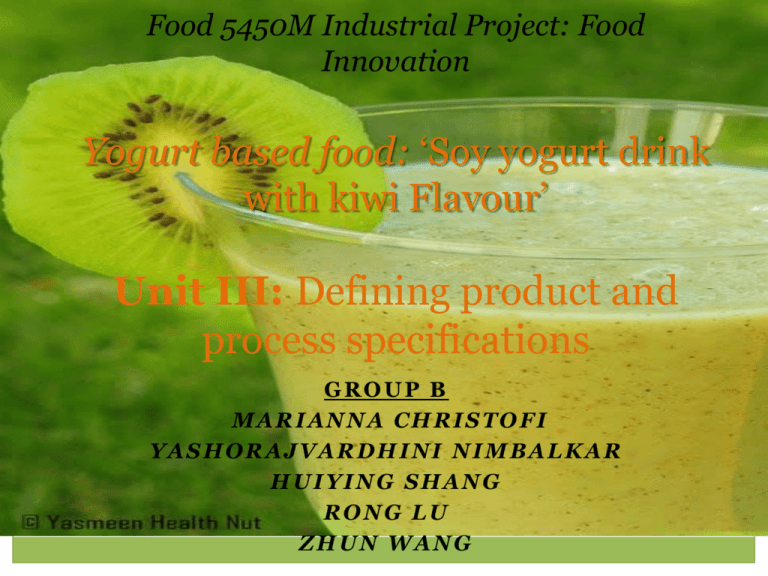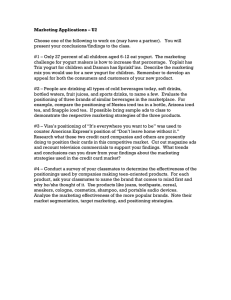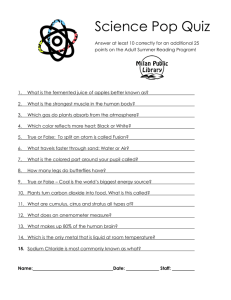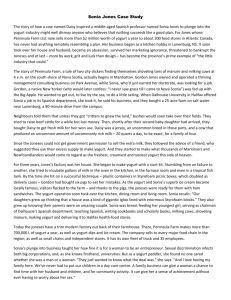Yogurt based food
advertisement

Food 5450M Industrial Project: Food Innovation Yogurt based food: ‘Soy yogurt drink with kiwi Flavour’ Unit III: Defining product and process specifications GROUP B MARIANNA CHRISTOFI YASHORAJVARDHINI NIMBALKAR HUIYING SHANG RONG LU ZHUN WANG Introduction Aim : develop and optimize the final product defining the product and process specifications by: developing the process and equipment flowchart according to legislation specifications conducting consumer sensory and descriptive analysis Outline Process and equipment flowcharts for both laboratory and industrial scale Factory layout for the production process Design experiments for conducting product & process optimisation (Screening + Optimisation) Conduct sensory consumer & descriptive analysis Specify product & process formulations and determine whether are in compliance with relevant legislation Laboratory Process Flowchart Laboratory Process Flowchart 2 main processes Yogurt fermentation Kiwi juice Kiwi juice extraction extraction Laboratory Process Flowchart – Yogurt Fermentation Standardised cow’s milk • Fat -1.5-1.7% Pre-heat • Temp=42 o C, t=5-10 min Add skimmed milk powder • Final solid content: 20-25% solids Laboratory Process Flowchart – Yogurt Fermentation Inoculation with bacteria culture • Streptococcus thermophilus, Lactobacillus bulgaricus Fermentation • Temp=40 45°C, Time= 45 hrs Check lactic acid content (acidity) • Till is 1.5 % Laboratory Process Flowchart – Kiwi juice extraction Fresh kiwi • Mature kiwis Washing • With clean water Freezing • For 30 min at 30° C Laboratory Process Flowchart – Kiwi juice extraction Extraction of juice • Blending for 1 -2 min Mixing of juice and water • Sterilised water • Blending Deaeration • Prevention from contact with air Laboratory Process Flowchart Add sugar and soy yogurt • Blend for 1-2 min Mixing • Hand mixer • Time-12min Storage • Cold room • Temp- 4°C Industrial Flow Chart Industrial process Industrial processing carries three lines Cows yogurt Soy yogurt Kiwi juice Cows yogurt and Soy yogurt (Line 1 and 2) Receiving of milk and storage • Checking of quality parameters • Storage in silos at4° C Standardization • • • • Fat-1.5-1.7% SNF- 16% Evaporation Improves stability and firmer structure Pasteurisation • Temp= 62.8°C • Time=30min • Prevents deterioration of milk • Denaturation of protein Cows yogurt and Soy yogurt (Line 1 and 2) Homogenisation • Reducing size of fat globules • Temp=40-65⁰C Inoculation and Fermentation • (1-2%) Streptococcus thermophilus and Lactobacillus bulgaricus • Temp=40-45⁰C • Time= 4-5 hour • convert sugar into lactic acid • pH of final yogurt=4.2-4.5 • Preparation of stirred yogurt Kiwi juice (Line 3) Receiving kiwis • Same variety and maturity Sorting • Size, appearance • Remove rotten, unripened or extremely ripened Washing • In running water with 0.1% KMNO4 Kiwi juice (Line 3) Drying • Cold air line • To prevent deterioration due to moisture Chilling • In cold room at-18⁰C for 30min Peeling • Outer skin of kiwi is removed Kiwi juice (Line 3) Remove middle hard core part • Difficulty in blending • Causes bitterness Cutting • Small pieces to make extraction easier Extraction of juice • Blending • Not for longer time to avoid braking of seeds Kiwi juice (Line 3) Coarse filtering • Uncrushed part, fine colloidal particles are removed Mixing with water • Soft water • Boiled at 100⁰ C and cool to 4⁰C. Standardization • pH=3.55, Acidity=0. 14%, TSS= 13% Kiwi juice (Line 3) Deaeration • Avoid contact of juice with air to prevent oxidation Mixing • Blending of soy yogurt, cows yogurt, sugar, kiwi juice together • Stabiliser(0.01%) and citric acid(0.8%) Checking of parameter • MSNF=89.5%, Fat= 1.3-1.5%, pH= 4-4.5 Kiwi juice (Line 3) Homogenisation • Disruption of particles at pressure of 6MPa Removing air from bottles and filling • Remove Dust, dirt, air • High speed filling • Aseptic filling Sealing and sterilization of bottles • Temp40⁰C • Time- 23min Equipment Equipments Selection Principle • Capacity 5000----10000 units 2500l/day • Time • Standards • Processing requirements • CIP • GMP • HACCP • Cost Equipment Tanks - Storage tank - Fermentation tank - Multipurpose tank Fermentation only Tank: Fermentation/Cooling Tank 2500 Litre Seperator -The TS-500-0 seperator -The final fat content of the milk process is within pre-set limits (0%- 3,5%) Equipment Bath pasterurizer 500-1,000 L/Batch,65°C Homogenizer The TH-025 homogenizer ,500L per hour 0-65°C Cooling system The cooling system (TC-6000) temperature ranges from 2-4°C Filling machine The Dogaseptic series Blender Gasti DOGAmix 60 Equipment Deaerator FrymaKoruma Vacuum Deaerating Unit type VE Labelling machine Heat exchanger plate heat exchanger (PHE) tubular heat exchanger, including the multitube or multichannel designs scraped/swept surface heat exchanger. CIP system Regulations Drinking yogurt-------yogurt products Flavoured fermented milk-------not contain more than 15% of fruit Milk protein in fermented milk and yogurt >2.7%, Milk fat in fermented milk <10% and <15% in yogurt Acidity (expressed as the percentage of lactic acid) of fermented milk >0.3% and 0.6% in yogurt Sum of the microorganisms constituting started culture > 107 in both fermented milk and yogurt Regulations Pasteurization - Temperature>71.7°C for 15 seconds or >62.8°C for 30 minutes then cooled to 10°C Labelling - List of ingredients - Food Labelling regulation (1996) - Allergies Information: milk, soy Factory Layout 食品工厂设计 Factory Layout Design Ensure a appropriate layout is to: Comply with Accreditation Standard requirements Legislative requirements Efficient utilization of resources Plan of layout Raw material warehouse Production area Packaging workshop Refrigeration plant Laboratory Locker room and toilet Electricity substation room and machine repair shop Reserving area KIWI Juice Important point for layout design All functions should processed with no criss-crossing and backtracking Visitors should move from clean to unclean areas Ingredients should move from dirty and clean area as they become incorporated into food products Conditioned air and drainage should flow from clean to dirty areas The flow of discarded outer packaging material should not cross the flow of products There is sufficient space for plant operations including processing, cleaning and maintenance. Space is also required for movement of materials and pedestrians Experiment design and screening experiment results Product acceptability and preference experiment design Preference test with 9-point hedonic scale Complete block design The questionnaire was designed using the Compusense five Samples were presented in balance, random, order according to randomised block design All samples were prepared on the same day of the test with the same way, using the same raw materials, and under the same conditions Table 1. The 9-point hedonic scale Product acceptability and preference experiment design Factor % cow’s yogurt % water % kiwi juice % sugar Lower limit 7.2 13 8 6 Upper limit 36.5 34 15 15 Table 2. Screening experiment: factors’ limits 16 samples: LLLL, LLLH, LLHL, LLHH, LHLL, LHLH, LHHL, LHHH, HLLL, HLLH, HLHL, HLHH, HHLL, HHLH, HHHL, HHHH The 16 samples were evaluated for overall acceptability by 32 untrained assessors in two sessions, 8 samples for each session Product acceptability and preference experiment design Factor % kiwi Lower level (L) Medium level (M) 8 10 % cow’s yogurt 7.2 14.7 High level (H) 12 22.2 Table 3. Optimisation experiment, factors’ limits 9 samples: LL, LM, LH, ML, MM, MH, HL, HM, HH 9 samples were examined by 54 untrained assessors in a single session Screening results analysis Assessors prefer the product with low kiwi %, low cow’s yoghurt % and high % of water The response of the assessors shows that the products with best sweetness are those with middle percentage of sugar Optimization results analysis Optimization result analysis Figure 1. Response surface plot for Kiwi flavor, (X1= % cow’s yogurt, X2=% kiwi juice) Optimization results analysis Figure 2. Response surface plot for milk flavor, (X1= % cow’s yogurt, X2=% kiwi juice) Optimization results analysis Figure 3. Response surface plot for overall acceptability, (X1= % cow’s yogurt, X2=% kiwi juice) The best formulation for percentage of kiwi juice and cow’s yogurt is at 14.5% and 9% Product formulation and Process specification Raw material Raw material (For 1000g drink) Cows yogurt Soy yogurt Water Kiwi Sugar Specification Quantity “Morrisons” low fat (1.5%) “Alpro” Sterilized tap water from lab “Morrisons” mature “ Morrisons” granulated sugar 14.5% (145gm) 47.5% (475 gm) 20% (200gm) 9% (90gm) 10% (100gm) Table 4. Raw material specification for lab scale Process specification Time Temperature pH Pressure Hygiene Microbiological and chemical parameters Product specification Raw material pH TSS Acidity % of fat SNF Packaging Primary Secondary Tertiary 250 ml PET Cartons Crates Conclusion Description of process and equipment flowcharts, and check if the production process is in compliance with relevant regulations Factory layout design for the production process Conduct product acceptability and preference test Design experiments for conducting product & process optimisation Determine product formulations & the process formulations Plan of action Thank you






